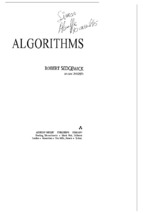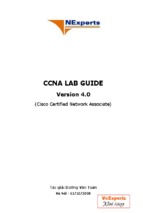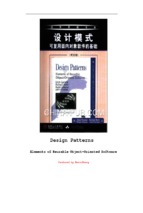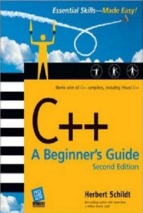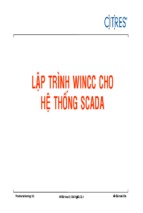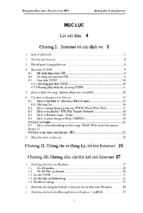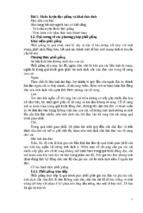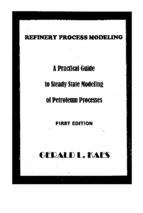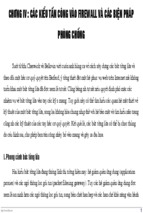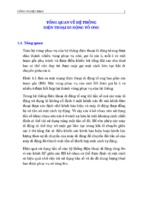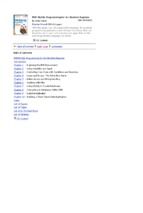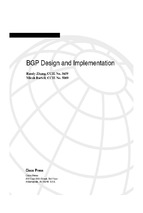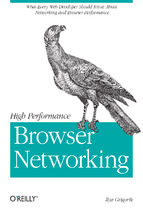Design Patterns
Elements of Reusable Object-Oriented Software
Produced by KevinZhang
Design Patterns: Elements of Reusable Object-Oriented Software
Contents
Preface to CD ........................................................ 5
Preface to Book ...................................................... 7
Foreword ............................................................. 9
Guide to Readers .................................................... 10
1 Introduction ...................................................... 11
1.1 What Is a Design Pattern? ...................................... 12
1.2 Design Patterns in Smalltalk MVC ............................... 14
1.3 Describing Design Patterns ..................................... 16
1.4 The Catalog of Design Patterns ................................. 18
1.5 Organizing the Catalog ......................................... 21
1.6 How Design Patterns Solve Design Problems ...................... 23
1.7 How to Select a Design Pattern ................................. 42
1.8 How to Use a Design Pattern .................................... 44
2 A Case Study: Designing a Document Editor ......................... 46
2.1 Design Problems ................................................ 46
2.2 Document Structure ............................................. 47
2.3 Formatting ..................................................... 53
2.4 Embellishing the User Interface ................................ 56
2.5 Supporting Multiple Look-and-Feel Standards .................... 60
2.6 Supporting Multiple Window Systems ............................. 64
2.7 User Operations ................................................ 72
2.8 Spelling Checking and Hyphenation .............................. 77
2.9 Summary ........................................................ 90
Design Pattern Catalog .............................................. 93
3 Creational Patterns ............................................... 94
Abstract Factory ................................................... 99
Builder ........................................................... 110
Factory Method .................................................... 121
Prototype ......................................................... 133
Singleton ......................................................... 144
Discussion of Creational Patterns .................................. 153
2
Design Patterns: Elements of Reusable Object-Oriented Software
4 Structural Patterns .............................................. 155
Adapter ........................................................... 157
Bridge ............................................................ 171
Composite ......................................................... 183
Decorator ......................................................... 196
Façade ............................................................ 208
Flyweight ......................................................... 218
Proxy ............................................................. 233
Discussion of Structural Patterns ................................. 246
5 Behavioral Patterns .............................................. 249
Chain of Responsibility ........................................... 251
Command ........................................................... 263
Interpreter ....................................................... 274
Iterator .......................................................... 289
Mediator .......................................................... 305
Memento ........................................................... 316
Observer .......................................................... 326
State ............................................................. 338
Strategy .......................................................... 349
Template Method ................................................... 360
Visitor ........................................................... 366
Discussion of Behavioral Patterns ................................. 382
6 Conclusion ....................................................... 388
6.1 What to Expect from Design Patterns ........................... 388
6.2 A Brief History ............................................... 392
6.3 The Pattern Community ......................................... 393
6.4 An Invitation ................................................. 395
6.5 A Parting Thought ............................................. 396
A Glossary ......................................................... 397
B Guide to Notation ................................................ 404
B.1 Class Diagram ................................................. 404
B.2 Object Diagram ................................................ 406
B.3 Interaction Diagram ........................................... 407
C Foundation Classes ............................................... 409
C.1 List .......................................................... 409
C.2 Iterator ...................................................... 412
C.3 ListIterator .................................................. 413
3
Design Patterns: Elements of Reusable Object-Oriented Software
C.4 Point ......................................................... 413
C.5 Rect .......................................................... 414
Bibliography ....................................................... 416
4
Design Patterns: Elements of Reusable Object-Oriented Software
Preface to CD
As we were writing Design Patterns, we knew the patterns we weredescribing had
value because they had proven themselves in manydifferent contexts. Our hope was
that other software engineers wouldbenefit from these patterns as much as we had.
Now, three years after its debut, we find ourselves both grateful andthrilled
by how the book has been received. Lots of people use it.Many tell us the patterns
have helped them design and build bettersystems. Many others have been inspired
to write their own patterns,and the pool of patterns is growing. And many have
commented on whatmight be improved about the book and what they would like to
see inthe future.
A recurring comment in all the feedback has been how well-suited thebook is to
hypertext. There are numerous cross-references, andchasing references is
something a computer can do very well. Sincemuch of the software development
process takes place on computers, itwould be natural to have a book like ours
as an on-line resource.Observations like these got us excited about the potential
of thismedium. So when Mike Hendrickson approached us about turning the bookinto
a CD-ROM, we jumped at the chance.
Two years and several megabytes of e-mail later, we're delighted thatyou can
finally obtain this edition, the Design Patterns CD,and put its unique capabilities
to work. Now you can access a patternfrom your computer even when someone has
borrowed your book. You can search the text for key words and phrases. It's also
considerably easier to incorporate parts of it in your own on-line
documentation.And if you travel with a notebook computer, you can keep the
bookhandy without lugging an extra two pounds of paper.
Hypertext is a relatively new publishing venue, one we arelearning to use just
like everyone else. If you have ideas on howto improve this edition, please send
them
[email protected] you have questions or suggestions
concerning the patternsthemselves, send them to
[email protected] list. (To subscribe, send e-mail to
[email protected] the subject "subscribe".) This list has quite
a few readers, and many of them can answer questions as well as we can—andusually
a lot faster! Also, be sure to check out thePatterns Home Page
athttp://hillside.net/patterns/.There you'll find other books and mailing lists
on patterns, notto mention conference information and patterns published on-line.
This CD entailed considerable design and implementation work. We areindebted to
Mike Hendrickson and the team at Addison-Wesley for theiron-going encouragement
and support. Jeff Helgesen, Jason Jones, andDaniel Savarese garner many thanks
5
Design Patterns: Elements of Reusable Object-Oriented Software
for their development effort andfor patience despite what must appear to have
been our insatiableappetite for revision. A special acknowledgment is due IBM
Research,which continues to underwrite much of this activity. We also thankthe
reviewers, including Robert Brunner, Sandeep Dani, Bob Koss, ScottMeyers, Stefan
Schulz, and the Patterns Discussion Group at theUniversity of Illinois
Urbana-Champaign. Their advice led to at leastone major redesign and several minor
ones.
Finally, we thank all who have taken time to comment on DesignPatterns. Your
feedback has been invaluable to us as we striveto better our understanding and
presentation of this material.
Zurich, Switzerland
E.G.
Sydney, Australia
R.H.
Urbana, Illinois
R.J.
Hawthorne, New York
J.V.
August 1997
6
Design Patterns: Elements of Reusable Object-Oriented Software
Preface to Book
This book isn't an introduction to object-oriented technology or design. Many
books already do a good job of that. This book assumes you are reasonably proficient
in at least one object-oriented programming language, and you should have some
experience in object-oriented design as well. You definitely shouldn't have to
rush to the nearest dictionary the moment we mention "types" and "polymorphism,"
or "interface" as opposed to "implementation” inheritance.
On the other hand, this isn't an advanced technical treatise either. It’s a book
of design patterns that describes simple and elegant solutions to specific problems
in object-oriented software design. Design patterns capture solutions that have
developed and evolved overtime. Hence they aren't the designs people tend to
generate initially. They reflect untold redesign and recoding as developers have
struggled for greater reuse and flexibility in their software. Design patterns
capture these solutions in a succinct and easily applied form.
The design patterns require neither unusual language features nor amazing
programming tricks with which to astound your friends and managers. All can be
implemented in standard object-oriented languages, though they might take a little
more work than ad hoc solutions. But the extra effort invariably pays dividends
in increased flexibility and reusability.
Once you understand the design patterns and have had an "Aha!" (and not just a
"Huh?") experience with them, you won't ever think about object-oriented design
in the same way. You'll have insights that can make your own designs more flexible,
modular, reusable, and understandable—which is why you're interested in
object-oriented technology in the first place, right?
A word of warning and encouragement: Don't worry if you don’t understand this
book completely on the first reading. We didn’t understand it all on the first
writing! Remember that this isn't a book to read once and put on a shelf. We hope
you'll find yourself referring to it again and again for design insights and for
inspiration.
This book has had a long gestation. It has seen four countries, three of its authors'
marriages, and the birth of two (unrelated) offspring.Many people have had a part
in its development. Special thanks are due Bruce Anderson, Kent Beck, and André
Weinand for their inspiration and advice. We also thank those who reviewed drafts
of the manuscript: Roger Bielefeld, Grady Booch, Tom Cargill, Marshall Cline,
Ralph Hyre, Brian Kernighan, Thomas Laliberty, Mark Lorenz, Arthur Riel, Doug
Schmidt, Clovis Tondo, Steve Vinoski, andRebecca Wirfs-Brock. We are also grateful
to the team at Addison-Wesley for their help and patience: Kate Habib,Tiffany
Moore,Lisa Raffaele,Pradeepa Siva, and John Wait.Special thanks to Carl Kessler,
7
Design Patterns: Elements of Reusable Object-Oriented Software
Danny Sabbah, and Mark Wegman at IBMResearch for their unflagging support of this
work.
Last but certainly not least, we thank everyone on the Internet andpoints beyond
who commented on versions of the patterns, offeredencouraging words, and told
us that what we were doing was worthwhile.These people include but are not limited
toJon Avotins,Steve Berczuk,Julian Berdych,Matthias Bohlen,John Brant,Allan
Clarke,Paul Chisholm,Jens Coldewey,Dave Collins,Jim Coplien,Don
Dwiggins,Gabriele Elia,Doug Felt,Brian Foote,Denis Fortin,Ward Harold,Hermann
Hueni,Nayeem Islam,Bikramjit Kalra,Paul Keefer,Thomas Kofler,Doug Lea,Dan
LaLiberte,James Long,Ann Louise Luu,Pundi Madhavan,Brian Marick,Robert
Martin,Dave McComb,Carl McConnell,Christine Mingins,Hanspeter Mössenböck,Eric
Newton,Marianne Ozkan,Roxsan Payette,Larry Podmolik,George Radin,Sita
Ramakrishnan,Russ Ramirez,Alexander Ran,Dirk Riehle,Bryan Rosenburg,Aamod
Sane,Duri Schmidt,Robert Seidl,Xin Shu,and Bill Walker.
We don't consider this collection of design patterns complete andstatic; it's
more a recording of our current thoughts on design. Wewelcome comments on it,
whether criticisms of our examples, referencesand known uses we've missed, or
design patterns we should haveincluded. You can write us care of Addison-Wesley,
or send electronicmail to
[email protected]. You can also
obtainsoftcopy for the code in the Sample Code sections by sending themessage
"send design pattern source" to
[email protected]. And now
there's a Web page at
http://st-www.cs.uiuc.edu/users/patterns/DPBook/DPBook.html for late-breaking
information and updates.
Mountain View, California
E.G.
Montreal, Quebec
R.H.
Urbana, Illinois
R.J.
Hawthorne, New York
J.V.
August 1994
8
Design Patterns: Elements of Reusable Object-Oriented Software
Foreword
Consider the work of a future software archeologist, tracingthe history of
computing. The fossil record will likely show clearstrata: here is a layer formed
of assembly language artifacts,there is a layer populated with the skeletons of
high orderprogramming languages (with certain calcified legacy partsprobably
still showing some signs of life). Each such layer willbe intersected with the
imprint of other factors that have shapedthe software landscape: components,
residue from the greatoperating system and browser wars, methods, processes, tools.
Eachline in this strata marks a definitive event: below that line,computing was
this way; above that line, the art of computing hadchanged.
Design Patterns draws such a line of demarcation;this is a work that represents
a change in the practice ofcomputing. Erich, Richard, Ralph, and John present
a compellingcase for the importance of patterns in crafting complex
systems.Additionally, they give us a language of common patterns that canbe used
in a variety of domains.
The impact of this work cannot be overstated. As I travel aboutthe world working
with projects of varying domains andcomplexities, it is uncommon for me to
encounter developers whohave not at least heard of the patterns movement. In the
moresuccessful projects, it is quite common to see many of thesedesign patterns
actually used.
With this book, the Gang of Four have made a seminalcontribution to software
engineering. There is much to learnedfrom them, and much to be actively applied.
Grady Booch
Chief Scientist, Rational Software Corporation
9
Design Patterns: Elements of Reusable Object-Oriented Software
Guide to Readers
This book has two main parts. The first part (Chapters 1 and 2)describes what
design patterns are and how they help you designobject-oriented software. It
includes a design case study thatdemonstrates how design patterns apply in practice.
The second partof the book (Chapters 3, 4, and 5) is a catalog of the actual
designpatterns.
The catalog makes up the majority of the book. Its chapters dividethe design
patterns into three types: creational, structural, andbehavioral. You can use
the catalog in several ways. You can readthe catalog from start to finish, or
you can just browse from patternto pattern. Another approach is to study one of
the chapters. Thatwill help you see how closely related patterns distinguish
themselves.
You can use the references between the patterns as a logicalroute through the
catalog. This approach will give you insightinto how patterns relate to each other,
how they can be combinedwith other patterns, and which patterns work well together.
Figure 1.1(page 23) depicts these references graphically.
Yet another way to read the catalog is to use a more problem-directedapproach.
Skip to Section 1.6 (page 23) to read about some common problems in designing
reusable object-orientedsoftware; then read the patterns that address these
problems. Somepeople read the catalog through first and then use aproblem-directed
approach to apply the patterns to their projects.
If you aren't an experienced object-oriented designer, then start withthe simplest
and most common patterns:
•
Abstract Factory (page 99)
•
Adapter (157)
•
Composite (183)
•
Decorator (196)
•
Factory Method (121)
•
Observer (326)
•
Strategy (349)
•
Template Method (360)
It's hard to find an object-oriented system that doesn't use at leasta couple
of these patterns, and large systems use nearly all of them.This subset will help
you understand design patterns in particular andgood object-oriented design in
general.
10
Design Patterns: Elements of Reusable Object-Oriented Software
1.
Introduction
Designing object-oriented software is hard, and designing reusable
object-oriented software is even harder. You must find pertinent objects, factor
them into classes at the right granularity, define class interfaces and inheritance
hierarchies, and establish key relationships among them. Your design should be
specific to the problem at hand but also general enough to address future problems
and requirements. You also want to avoid redesign, or at least minimize it.
Experienced object-oriented designers will tell you that a reusable and flexible
design is difficult if not impossible to get "right" the first time. Before a
design is finished, they usually try to reuse it several times, modifying it each
time.
Yet experienced object-oriented designers do make good designs. Meanwhile new
designers are overwhelmed by the options available and tend to fall back on
non-object-oriented techniques they've used before. It takes a long time for
novices to learn what good object-oriented design is all about. Experienced
designers evidently know something inexperienced ones don't. What is it?
One thing expert designers know not to do is solve every problem from first
principles. Rather, they reuse solutions that have worked for them in the past.
When they find a good solution, they use it again and again. Such experience is
part of what makes them experts. Consequently, you'll find recurring patterns
of classes and communicating objects in many object-oriented systems. These
patterns solve specific design problems and make object-oriented designs more
flexible, elegant, and ultimately reusable. They help designers reuse successful
designs by basing new designs on prior experience. A designer who is familiar
with such patterns can apply them immediately to design problems without having
to rediscover them.
An analogy will help illustrate the point. Novelists and playwrights rarely design
their plots from scratch. Instead, they follow patterns like "Tragically Flawed
Hero" (Macbeth, Hamlet, etc.) or "The Romantic Novel" (countless romance novels).
In the same way, object-oriented designers follow patterns like "represent states
with objects" and "decorate objects so you can easily add/remove features." Once
you know the pattern, a lot of design decisions follow automatically.
We all know the value of design experience. How many times have you had design
déjà-vu—that feeling that you've solved a problem before but not knowing exactly
where or how? If you could remember the details of the previous problem and how
you solved it, then you could reuse the experience instead of rediscovering it.
However, we don't do a good job of recording experience in software design for
others to use.
11
Design Patterns: Elements of Reusable Object-Oriented Software
The purpose of this book is to record experience in designing object-oriented
software as design patterns. Each design pattern systematically names, explains,
and evaluates an important and recurring design in object-oriented systems. Our
goal is to capture design experience in a form that people can use effectively.
To this end we have documented some of the most important design patterns and
present them as a catalog.
Design patterns make it easier to reuse successful designs and architectures.
Expressing proven techniques as design patterns makes them more accessible to
developers of new systems. Design patterns help you choose design alternatives
that make a system reusable and avoid alternatives that compromise reusability.
Design patterns can even improve the documentation and maintenance of existing
systems by furnishing an explicit specification of class and object interactions
and their underlying intent. Put simply, design patterns help a designer get a
design "right" faster.
None of the design patterns in this book describes new or unproven designs. We
have included only designs that have been applied more than once in different
systems. Most of these designs have never been documented before. They are either
part of the folklore of the object-oriented community or are elements of some
successful object-oriented systems—neither of which is easy for novice designers
to learn from. So although these designs aren't new, we capture them in a new
and accessible way: as a catalog of design patterns having a consistent format.
Despite the book's size, the design patterns in it capture only a fraction of
what an expert might know. It doesn't have any patterns dealing with concurrency
or distributed programming or real-time programming. It doesn't have any
application domain-specific patterns. It doesn't tell you how to build user
interfaces, how to write device drivers, or how to use an object-oriented database.
Each of these areas has its own patterns, and it would be worthwhile for someone
to catalog those too.
What is a Design Pattern?
Christopher Alexander says, "Each pattern describes a problem which occurs over
and over again in our environment, and then describes the core of the solution
to that problem, in such a way that you can use this solution a million times
over, without ever doing it the same way twice" [AIS+77]. Even though Alexander
was talking about patterns in buildings and towns, what he says is true about
object-oriented design patterns. Our solutions are expressed in terms of objects
and interfaces instead of walls and doors, but at the core of both kinds of patterns
is a solution to a problem in a context.
In general, a pattern has four essential elements:
12
Design Patterns: Elements of Reusable Object-Oriented Software
1. The pattern name is a handle we can use to describe a design problem, its
solutions, and consequences in a word or two. Naming a pattern immediately
increases our design vocabulary. It lets us design at a higher level of
abstraction. Having a vocabulary for patterns lets us talk about them with
our colleagues, in our documentation, and even to ourselves. It makes it
easier to think about designs and to communicate them and their trade-offs
to others. Finding good names has been one of the hardest parts of developing
our catalog.
2. The problem describes when to apply the pattern. It explains the problem
and its context. It might describe specific design problems such as how
to represent algorithms as objects. It might describe class or object
structures that are symptomatic of an inflexible design. Sometimes the
problem will include a list of conditions that must be met before it makes
sense to apply the pattern.
3. The solution describes the elements that make up the design, their
relationships, responsibilities, and collaborations. The solution doesn't
describe a particular concrete design or implementation, because a pattern
is like a template that can be applied in many different situations. Instead,
the pattern provides an abstract description of a design problem and how
a general arrangement of elements (classes and objects in our case) solves
it.
4. The consequences are the results and trade-offs of applying the pattern.
Though consequences are often unvoiced when we describe design decisions,
they are critical for evaluating design alternatives and for understanding
the costs and benefits of applying the pattern. The consequences for
software often concern space and time trade-offs. They may address language
and implementation issues as well. Since reuse is often a factor in
object-oriented design, the consequences of a pattern include its impact
on a system's flexibility, extensibility, or portability. Listing these
consequences explicitly helps you understand and evaluate them.
Point of view affects one's interpretation of what is and isn't a pattern. One
person's pattern can be another person's primitive building block. For this book
we have concentrated on patterns at a certain level of abstraction. Design patterns
are not about designs such as linked lists and hash tables that can be encoded
in classes and reused as is. Nor are they complex, domain-specific designs for
an entire application or subsystem. The design patterns in this book are
descriptions of communicating objects and classes that are customized to solve
a general design problem in a particular context.
A design pattern names, abstracts, and identifies the key aspects of a common
design structure that make it useful for creating a reusable object-oriented design.
The design pattern identifies the participating classes and instances, their roles
and collaborations, and the distribution of responsibilities. Each design pattern
13
Design Patterns: Elements of Reusable Object-Oriented Software
focuses on a particular object-oriented design problem or issue. It describes
when it applies, whether it can be applied in view of other design constraints,
and the consequences and trade-offs of its use. Since we must eventually implement
our designs, a design pattern also provides sample C++ and (sometimes) Smalltalk
code to illustrate an implementation.
Although design patterns describe object-oriented designs, they are based on
practical solutions that have been implemented in mainstream object-oriented
programming languages like Smalltalk and C++ rather than procedural languages
(Pascal, C, Ada) or more dynamic object-oriented languages (CLOS, Dylan, Self).
We chose Smalltalk and C++ for pragmatic reasons: Our day-to-day experience has
been in these languages, and they are increasingly popular.
The choice of programming language is important because it influences one's point
of view. Our patterns assume Smalltalk/C++-level language features, and that
choice determines what can and cannot be implemented easily. If we assumed
procedural languages, we might have included design patterns called "Inheritance,"
"Encapsulation," and "Polymorphism." Similarly, some of our patterns are supported
directly by the less common object-oriented languages. CLOS has multi-methods,
for example, which lessen the need for a pattern such as Visitor (page 366). In
fact, there are enough differences between Smalltalk and C++ to mean that some
patterns can be expressed more easily in one language than the other. (See Iterator
(289) for an example.)
Design Patterns in Smalltalk MVC
The Model/View/Controller (MVC) triad of classes [KP88] is used to build user
interfaces in Smalltalk-80. Looking at the design patterns inside MVC should help
you see what we mean by the term "pattern."
MVC consists of three kinds of objects. The Model is the application object, the
View is its screen presentation, and the Controller defines the way the user
interface reacts to user input. Before MVC, user interface designs tended to lump
these objects together. MVC decouples them to increase flexibility and reuse.
MVC decouples views and models by establishing a subscribe/notify protocol between
them. A view must ensure that its appearance reflects the state of the model.
Whenever the model's data changes, the model notifies views that depend on it.
In response, each view gets an opportunity to update itself. This approach lets
you attach multiple views to a model to provide different presentations. You can
also create new views for a model without rewriting it.
The following diagram shows a model and three views. (We've left out the controllers
for simplicity.) The model contains some data values, and the views defining a
14
Design Patterns: Elements of Reusable Object-Oriented Software
spreadsheet, histogram, and pie chart display these data in various ways. The
model communicates with its views when its values change, and the views communicate
with the model to access these values.
Taken at face value, this example reflects a design that decouples views from
models. But the design is applicable to a more general problem: decoupling objects
so that changes to one can affect any number of others without requiring the changed
object to know details of the others. This more general design is described by
the Observer (page 326) design pattern.
Another feature of MVC is that views can be nested. For example, a control panel
of buttons might be implemented as a complex view containing nested button views.
The user interface for an object inspector can consist of nested views that may
be reused in a debugger. MVC supports nested views with the CompositeView class,
a subclass of View. CompositeView objects act just like View objects; a composite
view can be used wherever a view can be used, but it also contains and manages
nested views.
Again, we could think of this as a design that lets us treat a composite view
just like we treat one of its components. But the design is applicable to a more
general problem, which occurs whenever we want to group objects and treat the
group like an individual object. This more general design is described by the
15
Design Patterns: Elements of Reusable Object-Oriented Software
Composite (183) design pattern. It lets you create a class hierarchy in which
some subclasses define primitive objects (e.g., Button) and other classes define
composite objects (CompositeView) that assemble the primitives into more complex
objects.
MVC also lets you change the way a view responds to user input without changing
its visual presentation. You might want to change the way it responds to the keyboard,
for example, or have it use a pop-up menu instead of command keys. MVC encapsulates
the response mechanism in a Controller object. There is a class hierarchy of
controllers, making it easy to create a new controller as a variation on an existing
one.
A view uses an instance of a Controller subclass to implement a particular response
strategy; to implement a different strategy, simply replace the instance with
a different kind of controller. It's even possible to change a view's controller
at run-time to let the view change the way it responds to user input. For example,
a view can be disabled so that it doesn't accept input simply by giving it a
controller that ignores input events.
The View-Controller relationship is an example of the Strategy (349) design pattern.
A Strategy is an object that represents an algorithm. It's useful when you want
to replace the algorithm either statically or dynamically, when you have a lot
of variants of the algorithm, or when the algorithm has complex data structures
that you want to encapsulate.
MVC uses other design patterns, such as Factory Method (121) to specify the default
controller class for a view and Decorator (196) to add scrolling to a view. But
the main relationships in MVC are given by the Observer, Composite, and Strategy
design patterns.
Describing Design Patterns
How do we describe design patterns?
Graphical notations, while important and
useful, aren't sufficient. They simply capture the end product of the design
process as relationships between classes and objects. To reuse the design, we
must also record the decisions, alternatives, and trade-offs that led to it.
Concrete examples are important too, because they help you see the design in action.
We describe design patterns using a consistent format. Each pattern is divided
into sections according to the following template. The template lends a uniform
structure to the information, making design patterns easier to learn, compare,
and use.
Pattern Name and Classification
16
Design Patterns: Elements of Reusable Object-Oriented Software
The pattern's name conveys the essence of the pattern succinctly. A
good name is vital, because it will become part of your design vocabulary.
The pattern's classification reflects the scheme we introduce in Section
1.5.
Intent
A short statement that answers the following questions: What does the
design pattern do? What is its rationale and intent? What particular design
issue or problem does it address?
Also Known As
Other well-known names for the pattern, if any.
Motivation
A scenario that illustrates a design problem and how the class and object
structures in the pattern solve the problem. The scenario will help you
understand the more abstract description of the pattern that follows.
Applicability
What are the situations in which the design pattern can be applied?
What are examples of poor designs that the pattern can address? How can
you recognize these situations?
Structure
A graphical representation of the classes in the pattern using a notation
based on the Object Modeling Technique (OMT) [RBP+91]. We also use
interaction diagrams [JCJO92, Boo94] to illustrate sequences of requests
and collaborations between objects. Appendix B describes these notations
in detail.
Participants
The classes and/or objects participating in the design pattern and their
responsibilities.
Collaborations
How the participants collaborate to carry out their responsibilities.
Consequences
17
Design Patterns: Elements of Reusable Object-Oriented Software
How does the pattern support its objectives? What are the trade-offs
and results of using the pattern? What aspect of system structure does it
let you vary independently?
Implementation
What pitfalls, hints, or techniques should you be aware of when
implementing the pattern? Are there language-specific issues?
Sample Code
Code fragments that illustrate how you might implement the pattern in
C++ or Smalltalk.
Known Uses
Examples of the pattern found in real systems. We include at least two
examples from different domains.
Related Patterns
What design patterns are closely related to this one? What are the
important differences? With which other patterns should this one be used?
The appendices provide background information that will help you understand the
patterns and the discussions surrounding them. Appendix A is a glossary of
terminology we use. We've already mentioned Appendix B, which presents the various
notations. We'll also describe aspects of the notations as we introduce them in
the upcoming discussions. Finally, Appendix C contains source code for the
foundation classes we use in code samples.
The Catalog of Design Patterns
The catalog beginning on page 93 contains 23 design patterns. Their names and
intents are listed next to give you an overview. The number in parentheses after
each pattern name gives the page number for the pattern (a convention we follow
throughout the book).
Abstract Factory (99)
Provide an interface for creating families of related or dependent
objects without specifying their concrete classes.
Adapter (157)
18
Design Patterns: Elements of Reusable Object-Oriented Software
Convert the interface of a class into another interface clients expect.
Adapter lets classes work together that couldn't otherwise because of
incompatible interfaces.
Bridge (171)
Decouple an abstraction from its implementation so that the two can
vary independently.
Builder (110)
Separate the construction of a complex object from its representation
so that the same construction process can create different representations.
Chain of Responsibility (251)
Avoid coupling the sender of a request to its receiver by giving more
than one object a chance to handle the request. Chain the receiving objects
and pass the request along the chain until an object handles it.
Command (263)
Encapsulate a request as an object, thereby letting you parameterize
clients with different requests, queue or log requests, and support undoable
operations.
Composite (183)
Compose
hierarchies.
objects
into
Composite
tree
lets
structures
clients
treat
to
represent
individual
part-whole
objects
and
compositions of objects uniformly.
Decorator (196)
Attach additional responsibilities to an object dynamically. Decorators
provide a flexible alternative to subclassing for extending functionality.
Facade (208)
Provide a unified interface to a set of interfaces in a subsystem. Facade
defines a higher-level interface that makes the subsystem easier to use.
Factory Method (121)
Define an interface for creating an object, but let subclasses decide
which class to instantiate. Factory Method lets a class defer instantiation
19
Design Patterns: Elements of Reusable Object-Oriented Software
to subclasses.
Flyweight (218)
Use
sharing
to
support
large
numbers
of
fine-grained
objects
efficiently.
Interpreter (274)
Given a language, define a represention for its grammar along with an
interpreter that uses the representation to interpret sentences in the
language.
Iterator (289)
Provide a way to access the elements of an aggregate object sequentially
without exposing its underlying representation.
Mediator (305)
Define an object that encapsulates how a set of objects interact.
Mediator promotes loose coupling by keeping objects from referring to each
other explicitly, and it lets you vary their interaction independently.
Memento (316)
Without violating encapsulation, capture and externalize an object's
internal state so that the object can be restored to this state later.
Observer (326)
Define a one-to-many dependency between objects so that when one object
changes state, all its dependents are notified and updated automatically.
Prototype (133)
Specify the kinds of objects to create using a prototypical instance,
and create new objects by copying this prototype.
Proxy (233)
Provide a surrogate or placeholder for another object to control access
to it.
Singleton (144)
20



